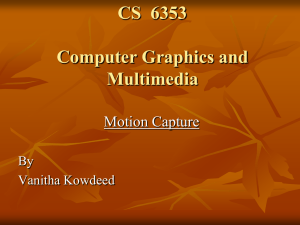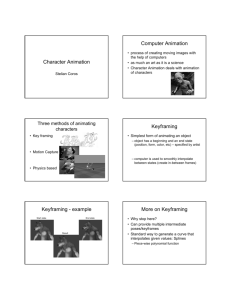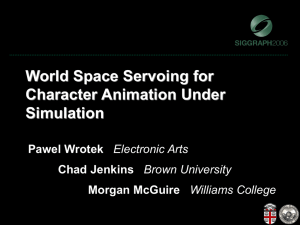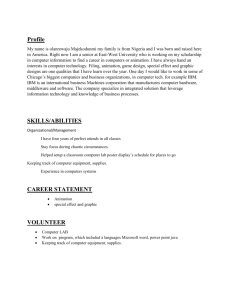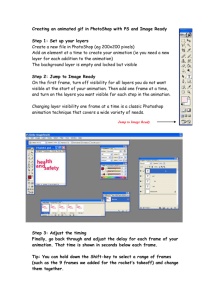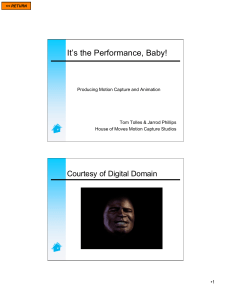Motion Capture Laboratory - The University of Texas at Dallas
advertisement
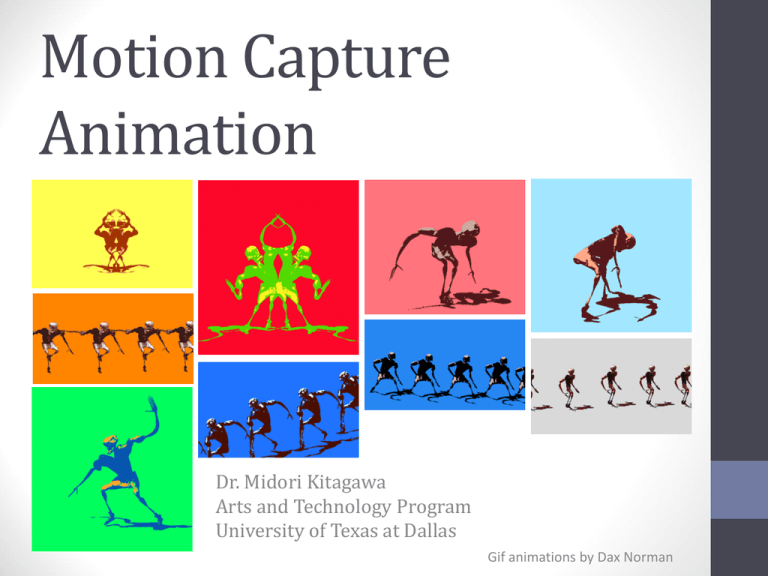
Motion Capture Animation Dr. Midori Kitagawa Arts and Technology Program University of Texas at Dallas Gif animations by Dax Norman What is Mocap? • Motion capture (mocap) is sampling and recording motion of humans, animals, and inanimate objects as 3D data. • The data can be used to study motion or to give an illusion of life to 3D computer models. Applications • • • • Entertainment Medicine / Sports Arts / Education Science / Engineering Entertainment: Live Action Films Entertainment: 3D computer animations Entertainment: Video Games Medicine / Sports • Medicine (e.g., gait analysis, rehabilitation) • Sports (e.g. injury prevention, performance analyses, performance enhancement) Arts / Education • Dance and theatrical performances • Archiving (e.g., Marcel Marceau) OSU/ACCAD Science / Engineering • Engineering (e.g., biped robot developments) • Computer Science (e.g., human motion database, indexing, recognitions) • Design (e.g., ergonomic product design) • Military (e.g., field exercises, virtual instructors, and roleplaying games) Mocap animation • Motion capture animation is different from keyframe animation in terms of how motion is created. • Same principles of animations apply to mocap animation & keyframe animation! • Combination of motion capture animation and keyframe animation is often used. Keyframe animation • Keyframe is a drawing of a key moment in an animated sequence, where the motion is at its extreme. • Inbetweens fill the gaps between keyframes. • Every motion is created by animators. Advantages of mocap animation • Faster to create (only if an established production pipeline exists.) • Secondary motions and all the subtle motions are captured. -> more realism • Physical interactions between performers and props can be captured. -> more realism Disadvantages of mocap animation • Cost. • Manipulating mocap data is often difficult -> Re-capturing or key framing a shot with bad data is often easier. • Mapping mocap data of a performer to a 3D character with a different proportion may cause issues. Popular types of mocap equipment • Magnetic systems • Mechanical systems • Optical systems Magnetic systems • Utilize sensors placed on the body to measure the magnetic field generated by a transmitter source. Magnetic systems • Require no special lighting condition. • Sensors are never occluded. • X Affected by electromagnetic force. Mechanical systems • Exoskeleton with angle sensors. Mechanical systems • • • • • Measure joint angles (no marker ID problems). Sensors are never occluded. X Breakable! X Configuration of sensors is fixed. X Constrains on joints. Optical systems • The cameras are equipped with infrared LED's and filters. • The cameras see reflector markers. Optical systems • • • • Higher sampling rate. Larger capture space. X Markers are sometimes occluded -> marker ID problems. X Provide only positional data -> joint angles need to be computed. Mocap system at UTD • Vicon optical system • 8 high-speed MX 13 (up to 10,000 fps) and 8 high-resolution MX 40 (4 megapixels) cameras. • Capture up to 5 performers at once. Mocap animation courses Graduate level: ATEC 6352 & UG level: ATEC 4345 • Group project based • Group of 3 to 5 members • Semester long project Pre-requisite: • ATEC 3317 Modeling and texturing OR • ATEC 3327 Lighting and composition Recommended: • ATEC 3328 Rigging I • ATEC 4337 Computer Animation Mocap animation pipeline Preproduction Capture -> data cleaning -> retargeting Modeling -> rigging ----------------------------- mocap animation Keyframe animation Effect animation Sound design Texturing/lighting -> Rendering -> Composition Post-production * Tasks that everyone should be involved. * Tasks that can be designated to a member or members. System Calibration and Capturing and Processing Data 2D Image -> 2D Camera Data -> 3D Markers Positions -> Trajectories -> Recon Skeleton -> Solver Skeleton Reconstruction Triangulation Circle fitting FBX Skeleton with subject’s size & proportion and motion data BLADE Subject Calibration VST • Capture Range of (subject Motion (ROM) template) • Reconstruct trajectories of ROM • Label markers VSK Skeleton with subject’s size & proportion Mocap Pipeline Flow Chart The processes that you go through for each character MOTION BUILDER Character Setup • Correlate : Character & Character Setup FBX • Create a skeleton The processes that you repeat for each shot MAYA Rendering MB Maya Scene File (FBX) • Edit motion Skeleton with 3D character’s size & proportion (and skin) • Bind skin to the skeleton • Rig the character Character • Marge the rigged character (MB) and the skeleton with motion data (FBX) • Edit motion (IK/FK blend, Trax) • Render • Bake motion data to the skeleton FBX Skeleton with motion data & 3D character’s size & proportion Dr. Midori Kitagawa midori@utdallas.edu ATEC 1.909

